Raman Spectroscopy and Electrical Transport in 30Li2O• (67−x) B2O3•(x) SiO2•3Al2O3 Glasses
Abstract
1. Introduction
2. Literature Review
2.1. Electrical Conductivity Literature
2.2. Glass Transition Temperature Literature
2.3. Raman Spectroscopy Literature
2.3.1. Borate Glasses
2.3.2. Silicate Glasses
2.3.3. Borosilicate Glasses
2.4. Spinodal Decomposition in Glasses
3. Experimental
3.1. Glass Synthesis
3.2. Electrical Conductivity Measurements
3.3. Raman Spectroscopy
4. Results
4.1. Glass Transition Temperature (Tg)
4.2. Electrical Conductivity (σ)
4.3. Raman Spectroscopy
4.3.1. Borate-Dominated 67B, 60B7Si, and 50B17Si Glasses
4.3.2. 40B27Si and 30B37Si Borosilicate Glasses
4.3.3. Silicate-Dominated 20B47Si, 10B57Si, and 67Si Glasses
5. Discussion
6. Conclusions
Author Contributions
Funding
Data Availability Statement
Conflicts of Interest
References
- Gardy, Z.A.; Wilkinson, C.J.; Randall, C.A.; Mauro, J.C. Emerging Role of Non-crystalline Electrolytes in Solid-State Battery Research. Front. Energy Res. 2020, 8, 218. [Google Scholar] [CrossRef]
- Chandra, A.; Bhatt, A.; Chandra, A. Ion Conduction in Superionic Glassy Electrolytes: An Overview. J. Mater. Sci. Technol. 2013, 29, 193–208. [Google Scholar] [CrossRef]
- Pradel, A.; Ribes, M. Ionic conductive glasses. Mater. Sci. Eng. B 1989, 3, 45–56. [Google Scholar] [CrossRef]
- Magistris, A.; Chiodelli, G.; Duclot, M. Silver boro-phosphate glasses: Ion transport, thermal stability and electrochemical behavior. Solid. State Ion. 1983, 9–10, 611–615. [Google Scholar] [CrossRef]
- Shuhaimi, S.A.; Hisam, R.; Yahya, A.K. Effects of mixed glass former on AC conductivity and dielectric properties of 70[xTeO2+(1-x) B2O3] +15Na2O+15K2O glass system. Solid. State Sci. 2020, 107, 106345. [Google Scholar] [CrossRef]
- Salodkar, R.V.; Deshpande, V.K.; Singh, K. Enhancement of the ionic conductivity of lithium boro-phosphate glass: A mixed glass former approach. J. Power Sources 1989, 25, 257–263. [Google Scholar] [CrossRef]
- Kumar, S.; Vinatier, P.; Levasseur, A.; Rao, K.J. Investigations of structure and transport in lithium and silver borophosphate glasses. J. Solid-State Chem. 2004, 177, 1723–1737. [Google Scholar] [CrossRef]
- Shaw, A.; Ghosh, A. Dynamics of lithium ions in borotellurite mixed former glasses: Correlation between the characteristic length scales of mobile ions and glass network structural units. J. Chem. Phys. 2014, 141, 164504. [Google Scholar] [CrossRef]
- Lee, C.H.; Joo, K.H.; Kim, J.H.; Woo, S.G.; Sohn, H.J.; Kang, T.; Park, Y.; Oh, J.Y. Characterizations of a new lithium ion conducting Li2O–SeO2–B2O3 glass electrolyte. Solid. State Ion. 2002, 149, 59–65. [Google Scholar] [CrossRef]
- Gundale, S.S.; Behare, V.V.; Deshpande, A.V. Study of electrical conductivity of Li2O-B2O3-SiO2-Li2SO4 glasses and glass-ceramics. Solid. State Ion. 2016, 298, 57–62. [Google Scholar] [CrossRef]
- Maia, L.F.; Rodrigues, A.C.M. Electrical conductivity and relaxation frequency of lithium borosilicate glasses. Solid. State Ion. 2004, 168, 87–92. [Google Scholar] [CrossRef]
- Otto, K. Electrical conductivity of SiO2-B2O3 glasses containing lithium or sodium. Phys. Chem. Glas. 1966, 7, 29–33. [Google Scholar]
- Doremus, R.H. Glass Science; Wiley: Hoboken, NJ, USA, 1994. [Google Scholar]
- McMillan, P.F. Structural studies of silicate glasses and melts: Applications and limitations of Raman spectroscopy. Am. Mineral. 1984, 69, 622–644. [Google Scholar]
- Hummel, R.E. Electrical Properties of Polymers, Ceramics, Dielectrics, and Amorphous Materials. In Electronic Properties of Materials; Springer: New York, NY, USA, 2011; pp. 181–211. [Google Scholar]
- Edward, S.J. Optimization of fast ionic conducting glasses for lithium batteries. Ph.D. Thesis, Iowa State University, Ames, IA, USA, 2005. [Google Scholar]
- Anderson, O.L.; Stuart, D.A. Calculation of Activation Energy of Ionic Conductivity in Silica Glasses by Classical Methods. J. Am. Ceram. Soc. 1954, 37, 553–582. [Google Scholar] [CrossRef]
- Ramadan, A.A.; Gould, R.D.; Ashour, A. On the Van Der Pauw method of resistivity measurements. Thin Solid. Film. 1994, 239, 272–275. [Google Scholar] [CrossRef]
- Bunde, A.; Funke, K.; Ingram, M.D. Ionic glasses: History and challenges. Solid. State Ion. 1998, 105, 1–13. [Google Scholar] [CrossRef]
- Montouillout, V.; Fan, H.; Campo, L.; Ory, S. Ionic conductivity of lithium borate glasses and local structure probed by high-resolution solid-sate NMR. J. Non-Cryst. Solids 2018, 484, 57–64. [Google Scholar] [CrossRef]
- Kluvanek, P.; Klement, R.; Karacon, M. Investigation of the conductivity of the lithium borosilicate glass system. J. Non-Cryst. Solids 2007, 353, 2004–2007. [Google Scholar] [CrossRef]
- Application Note Basics of Electrochemical Impedance Spectroscopy: Gamry Instruments. Available online: https://www.gamry.com/application-notes/EIS/basics-of-electrochemical-impedance-spectroscopy/ (accessed on 7 May 2023).
- Neyret, M.; Lenoir, M.; Grandjean, A.; Massoni, N.; Penelon, B.; Malki, M. Ionic transport of alkali in borosilicate glass. Role of alkali nature on glass structure and on ionic conductivity at the glassy state. J. Non-Cryst. Solids 2015, 410, 74–81. [Google Scholar] [CrossRef]
- Wright, A.C.; Dalba, G.; Rocca, F.; Vedishcheva, N.M. Borate versus silicate glasses: Why are they so different? Phys. Chem. Glas.-Eur. J. Glass Sci. Technol. 2010, 51, 233–265. [Google Scholar]
- Kodama, M.; Kojima, S. Anharmonicity and fragility in lithium borate glasses. J. Therm. Anal. Calorim. 2002, 69, 961–970. [Google Scholar] [CrossRef]
- Avramov, I.; Vassilev, T.; Penkov, I. The glass transition temperature of silicate and borate glasses. J. Non-Cryst. Solids 2005, 351, 472–476. [Google Scholar] [CrossRef]
- Boekenhauer, R.; Zhang, H.; Feller, S.; Bain, D.; Kambeyanda, S.; Budhwani, K.; Pandikuthira, P.; Alamgir, F.; Peters, A.M.; Messer, S.; et al. The glass transition temperature of lithium borosilicate glasses related to atomic arrangements. J. Non-Cryst. Solids 1994, 175, 137–144. [Google Scholar] [CrossRef]
- Yun, Y.H.; Bray, P.J. Nuclear magnetic resonance studies of the glasses in the system Na2O-B2O3-SiO2. J. Non-Cryst. Solids 1978, 27, 363–380. [Google Scholar] [CrossRef]
- Yun, Y.H.; Feller, S.A.; Bray, P.J. Correction and addendum to Nuclear Magnetic Resonance Studies of the Glasses in the System Na2O-B2O3-SiO2. J. Non-Cryst. Solids 1979, 33, 273–277. [Google Scholar] [CrossRef]
- Dell, W.J.; Bray, P.J.; Xiao, S.Z. 11B NMR studies and structural modeling of Na2O-B2O3-SiO2 glasses of high soda content. J. Non-Cryst. Solids 1983, 58, 1–16. [Google Scholar] [CrossRef]
- Meera, B.N.; Ramakrishna, J. Raman spectral studies of borate glasses. J. Non-Cryst. Solids 1993, 159, 1–21. [Google Scholar] [CrossRef]
- Konijnendijk, W.L.; Stevels, J.M. The Structure of Borate Glasses Studied by Raman Scattering. J. Non-Cryst. Solids 1975, 18, 307–331. [Google Scholar] [CrossRef]
- Konijnendijk, W.L.; Stevels, J.M. The Structure of Borosilicate Glasses Studied by Raman Scattering. J. Non-Cryst. Solids 1976, 20, 193–224. [Google Scholar] [CrossRef]
- Kamitsos, E.I.; Chryssikos, G.D. Borate glass structure by Raman and infrared spectroscopies. J. Mol. Struct. 1991, 247, 1–16. [Google Scholar] [CrossRef]
- Kamitsos, E.I.; Karakassides, M.A.; Chryssikos, G.D. Structure of borate glasses: Pt. 1. Phys. Chem. Glas. 1989, 30, 229–234. [Google Scholar]
- Winterstein-Beckmann, A.; Möncke, D.; Palles, D.; Kamitsos, E.I.; Wondraczek, L. A Raman-spectroscopic study of indentation-induced structural changes in technical alkali-borosilicate glasses with varying silicate network connectivity. J. Non Cryst. Solids 2014, 405, 196–206. [Google Scholar] [CrossRef]
- Krogh-Moe, B.J. The Crystal Structure of Lithium Diborate, Li2O.2B2O3. Acta Cryst. 1962, 15, 190–193. [Google Scholar] [CrossRef]
- Mozzi, R.L.; Warren, B.E. The structure of vitreous boron. J. Appl. Crystallogr. 1970, 3, 251–257. [Google Scholar] [CrossRef]
- Bril, T.W. Raman spectroscopy of crystalline and vitreous borates. Ph.D. Thesis, Technische Hogeschool Eindhoven, Eindhoven, The Netherlands, 1976. [Google Scholar] [CrossRef]
- Kamitsos, E.I.; Karakassides, A.; Chryssikost, G.D. Vibrational Spectra of Magnesium-Sodium-Borate Glasses. 2. Raman and Mid-Infrared Investigation of the Network Structure. J. Phys. Chem. 1987, 91, 11073–11079. Available online: https://pubs.acs.org/sharingguidelines (accessed on 15 August 2023). [CrossRef]
- Martizez-Ripoll, M.; Martinez-Carrera, S.; Garcia-Blanco, S. The Crystal Structure of Zinc Diborate ZnB4O7. Acta Cryst. 1971, B27, 672–677. [Google Scholar] [CrossRef]
- Kamitsos, E.I.; Karakassides, A. Structural Studies of Binary and Pseudo Binary Sodium Borate Glasses of High Sodium Content. Phys. Chem. Glas. 1989, 30, 19–26. [Google Scholar]
- Akagi, R.; Ohtori, N.; Umesaki, N. Raman spectra of K2O–B2O3 glasses and melts. J. Non-Cryst. Solids 2001, 295, 471–476. [Google Scholar] [CrossRef]
- Dwivedi, B.P.; Rahman, M.H.; Kumar, Y.; Khanna, B.N. Raman Scattering Study of Lithium Borate Glasses. J. Phys. Chem. Solids 1993, 54, 621–628. [Google Scholar] [CrossRef]
- Manara, D.; Grandjean, A.; Neuville, D.R. Advances in understanding the structure of borosilicate glasses: A Raman spectroscopy study. Am. Mineral. 2009, 94, 777–784. [Google Scholar] [CrossRef]
- Yano, T.; Kobayashi, T.; Shibata, S.; Yamane, M. High temperature Raman spectra of R2O-B2O3 glass melts. Phys. Chem. Glas. 2002, 43C, 90–95. [Google Scholar]
- Furukawa, T.; White, W.B. Raman spectroscopic investigation of sodium-boro silicate glass structure. J. Mater. Sci. 1981, 16, 2689–2700. [Google Scholar] [CrossRef]
- Furukawa, T.; Fox, K.E.; White, W.B. Raman spectroscopic investigation of the structure of silicate glasses. III. Raman intensities and structural units in sodium silicate glasses. J. Chem. Phys. 1998, 75, 3226–3237. [Google Scholar] [CrossRef]
- McKeown, D.A.; Nobles, A.C.; Bell, M.I. Vibrational analysis of wadeite K2ZrSi 3O9 and comparisons with benitoite BaTiSi3O9. Phys. Rev. B 1996, 54, 291. [Google Scholar] [CrossRef]
- McKeown, D.A.; Galeener, F.L.; Brown, G.E. Raman Studies of AI Coordination in Silica-Rich Sodium Aluminosilicate Glasses and some Related Minerals. J. Non-Cryst. Solids 1984, 68, 361. [Google Scholar] [CrossRef]
- McKeown, D.A.; Buechele, A.C.; Viragh, C.; Pegg, I.L. Raman and X-ray absorption spectroscopic studies of hydrothermally altered alkali-borosilicate nuclear waste glass. J. Nucl. Mater. 2010, 399, 13–25. [Google Scholar] [CrossRef]
- Seuthe, T.; Grehn, M.; Mermillod-Blondin, A.; Bonse, J.; Eberstein, M. Compositional dependent response of silica-based glasses to femtosecond laser pulse irradiation. In Laser-Induced Damage in Optical Materials: 2013; SPIE: Boulder, CO, USA, 2013; 88850M. [Google Scholar] [CrossRef]
- Zotov, N.; Keppler, H. The structure of sodium tetrasilicate glass from neutron diffraction, reverse Monte Carlo simulations and Raman spectroscopy. Phys. Chem. Miner. 1998, 25, 259–267. [Google Scholar] [CrossRef]
- Zotov, N.; Keppler, H. The influence of water on the structure of hydrous sodium tetrasilicate glasses. Am. Miner. 1998, 83, 823–834. [Google Scholar] [CrossRef]
- Osipov, A.A.; Osipova, L.M.; Eremyashev, V.E. Structure of alkali borosilicate glasses and melts according to Raman spectroscopy data. Glass Phys. Chem. 2013, 39, 105–112. [Google Scholar] [CrossRef]
- Phillips, M.W.; Gibbs, G.V.; Ribbe, P.H. The crystal structure of danburite: A comparison with anorthite, albite, and reedmergnerite. Am. Mineral. 1974, 59, 79–85. [Google Scholar]
- Johansson, G. A Refinement of the Crystal Structure of Danburite. Acta Cryst. 1959, 12, 522–526. [Google Scholar] [CrossRef]
- Bunker, B.C.; Tallant, D.R.; Kirkpatrick, R.J.; Turner, G.L. Multinuclear nuclear magnetic resonance and Raman investigation of sodium borosilicate glass structures. Phys. Chem. Glas. 1990, 31, 30–41. [Google Scholar]
- Manara, D.; Grandjean, A.; Neuville, D. Structure of borosilicate glasses and melts: A revision of the Yun, Bray and Dell model. J. Non-Cryst. Solids 2009, 355, 2528–2531. [Google Scholar] [CrossRef]
- Osipov, A.A.; Osipova, L.M. Structure of lithium borate glasses and melts: Investigation by high-temperature Raman spectroscopy. Eur. J. Glass Sci. Technol. 2009, 50, 343–354. [Google Scholar]
- Turner, W.E.S.; Winks, F.J. The Influence of Boric Oxide on the Properties of Chemical and Heat-resisting Glasses. Soc. Glass Technol. 1926, 10, 102–113. [Google Scholar]
- Cahn, J.W. On Spinodal Decomposition. Acta. Mate. 1961, 9, 795–801. [Google Scholar] [CrossRef]
- van der Pauw, L.J. A method of measuring the resistivity and Hall coefficient on lamellae of arbitrary shape. Philips Technol. Rev. 1958, 20, 220–224. [Google Scholar]
- Umari, P.; Pasquarello, A. First-principles analysis of the Raman spectrum of vitreous silica: Comparison with the vibrational density of states. J. Phys. Condens. Matter 2003, 15, S1547. [Google Scholar] [CrossRef]
- Igor Pro Manual, Version 6.3. 2015. Available online: http://www.wavemetrics.com/ (accessed on 3 January 2023).
- Chryssikos, G.D.; Kapoutsis, J.A.; Patsis, A.P.; Kamitsos, E.I. A classification of metaborate crystals based on Raman spectroscopy. Spectrochim. Acta Part. A Mol. Spectrosc. 1991, 47, 1117–1126. [Google Scholar] [CrossRef]
- Konijnendijk, W.L. The Structure of Borosilicate Glasses. Ph.D. Thesis, Technische Hogeschool Eindhoven, Eindhoven, The Netherlands, 1975. [Google Scholar] [CrossRef]
- Osipov, A.A.; Osipova, L.M. Structural studies of Na2O B2O3 glasses and melts using high-temperature Raman spectroscopy. Phys. Condens. Matter 2010, 405, 4718–4732. [Google Scholar] [CrossRef]
- Petrescu, S.; Constantinescu, M.; Anghel, E.M.; Atkinson, I.; Olteanu, M.; Zaharescu, M. Structural and physico-chemical characterization of some soda lime zinc alumino-silicate glasses. J. Non-Cryst. Solids 2012, 328, 3280–3288. [Google Scholar] [CrossRef]
- Umesaki, N.; Takahashi, M.; Tatsumisago, M.; Minami, T. Raman spectroscopic study of alkali silicate glasses and melts. J. Non-Cryst. Solids 1996, 205, 225–230. [Google Scholar] [CrossRef]
- McKeown, D.A.; Muller, I.S.; Buechele, A.C.; Pegg, I.L.; Kendziora, C.A. Structural characterization of high-zirconia borosilicate glasses using Raman spectroscopy. J. Non-Cryst. Solids 2000, 262, 126–134. [Google Scholar] [CrossRef]
- Mysen, B.O.; Frantz, J.D. Raman spectroscopy of silicate melts at magmatic temperatures: Na2O-SiO2, K2O-SiO2 and Li2O-SiO2 binary compositions in the temperature range 25–1475 °C. Chem. Geol. 1992, 96, 321–332. [Google Scholar] [CrossRef]
- Nascimento, M.; Dantas, N.O. Anderson-Stuart model of ionic conductors in Na2O-SiO2 glasses. Sci. Eng. J. 2003, 12, 7–13. [Google Scholar]
- Tatsumisago, M.; Yoneda, K.; Machida, N.; Minami, T. Ionic conductivity of rapidly quenched glasses with high concentration of lithium ions. J. Non-Cryst. Solids 1987, 95, 857–864. [Google Scholar] [CrossRef]
- Wright, A.C. My borate life: An enigmatic journey. Int. J. Appl. Glass Sci. 2015, 6, 45–63. [Google Scholar] [CrossRef]
- Galeener, F.L. Planar rings in glasses. Soild State Commun. 1982, 44, 1037–1040. [Google Scholar] [CrossRef]
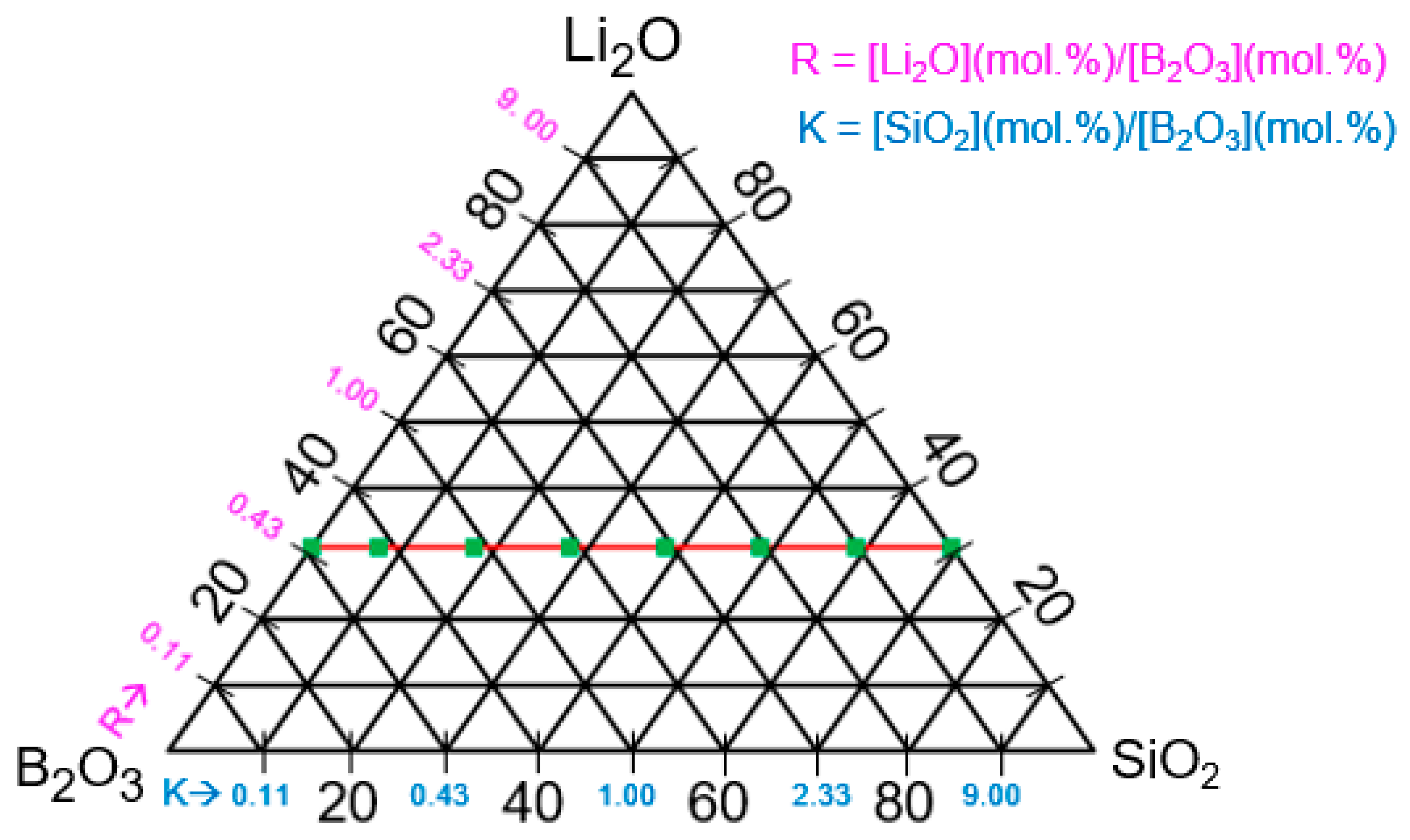
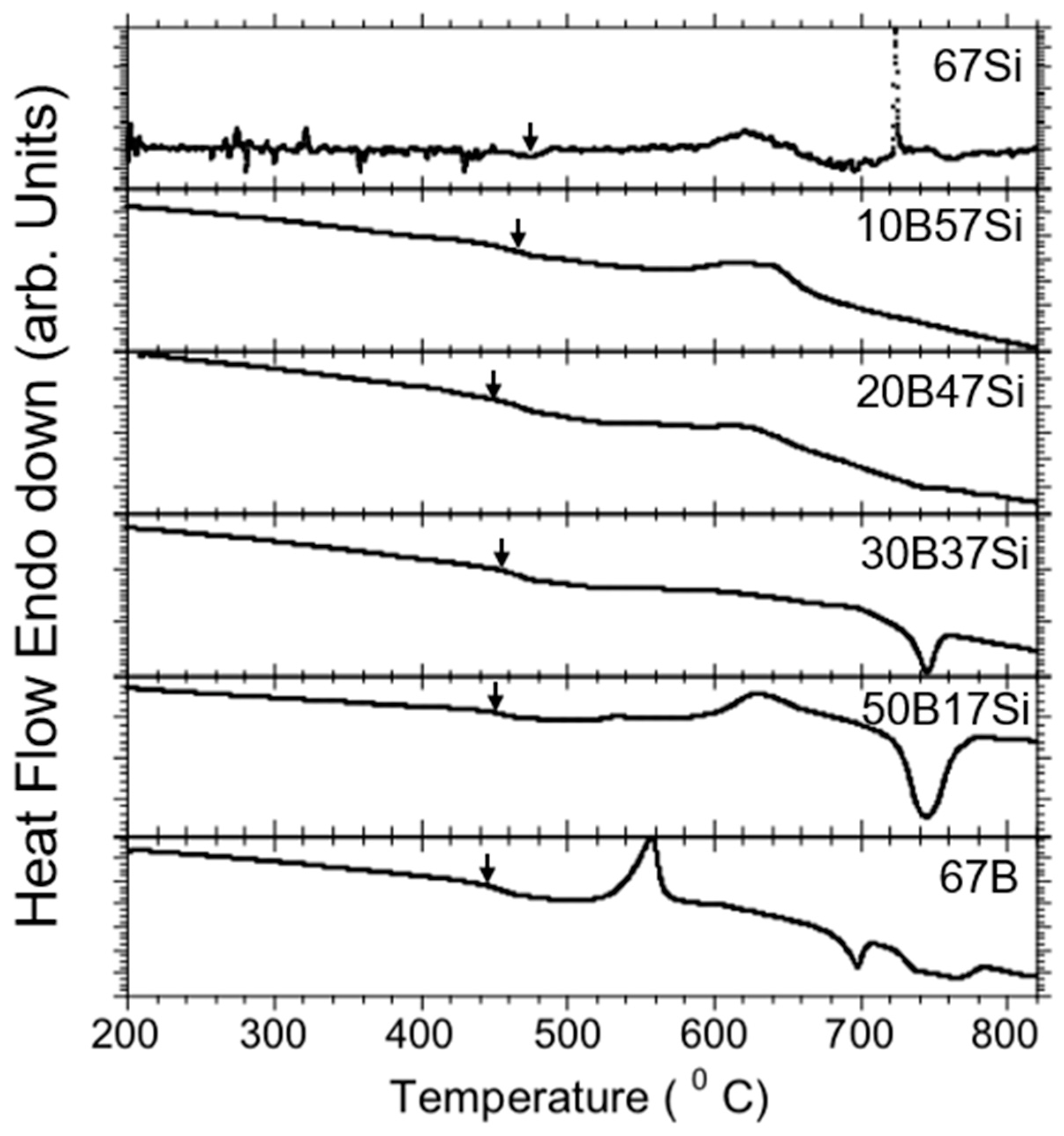
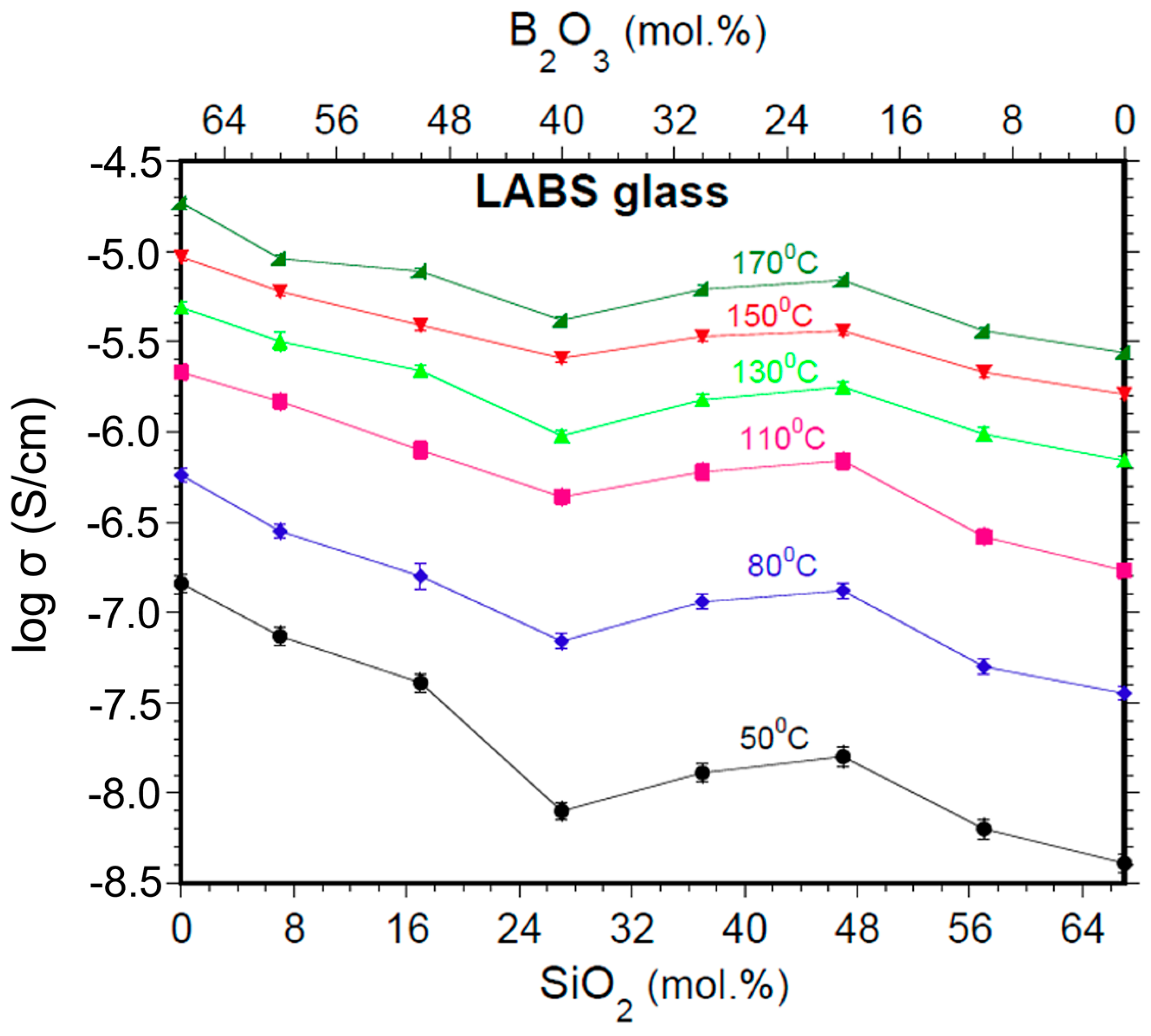
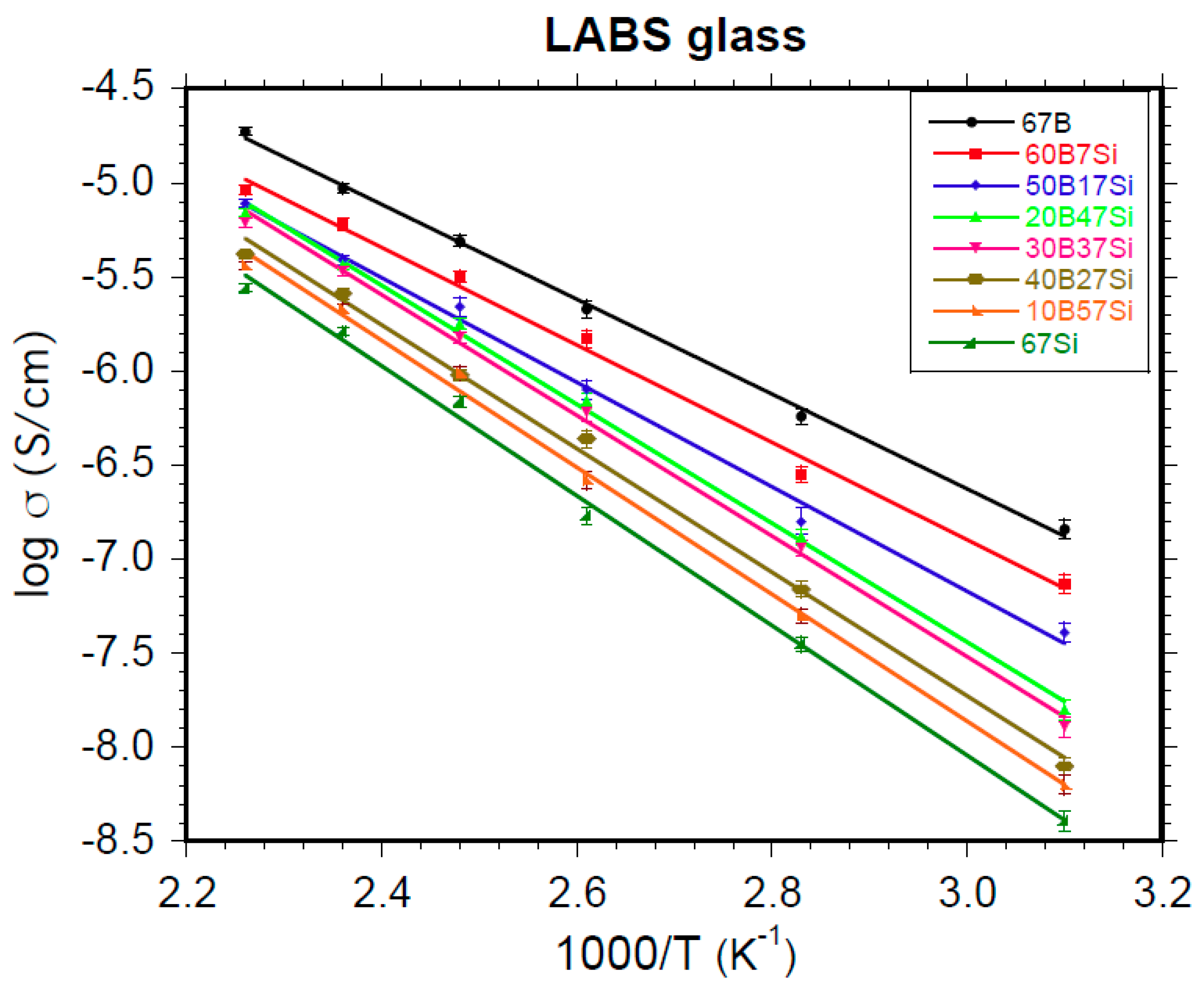


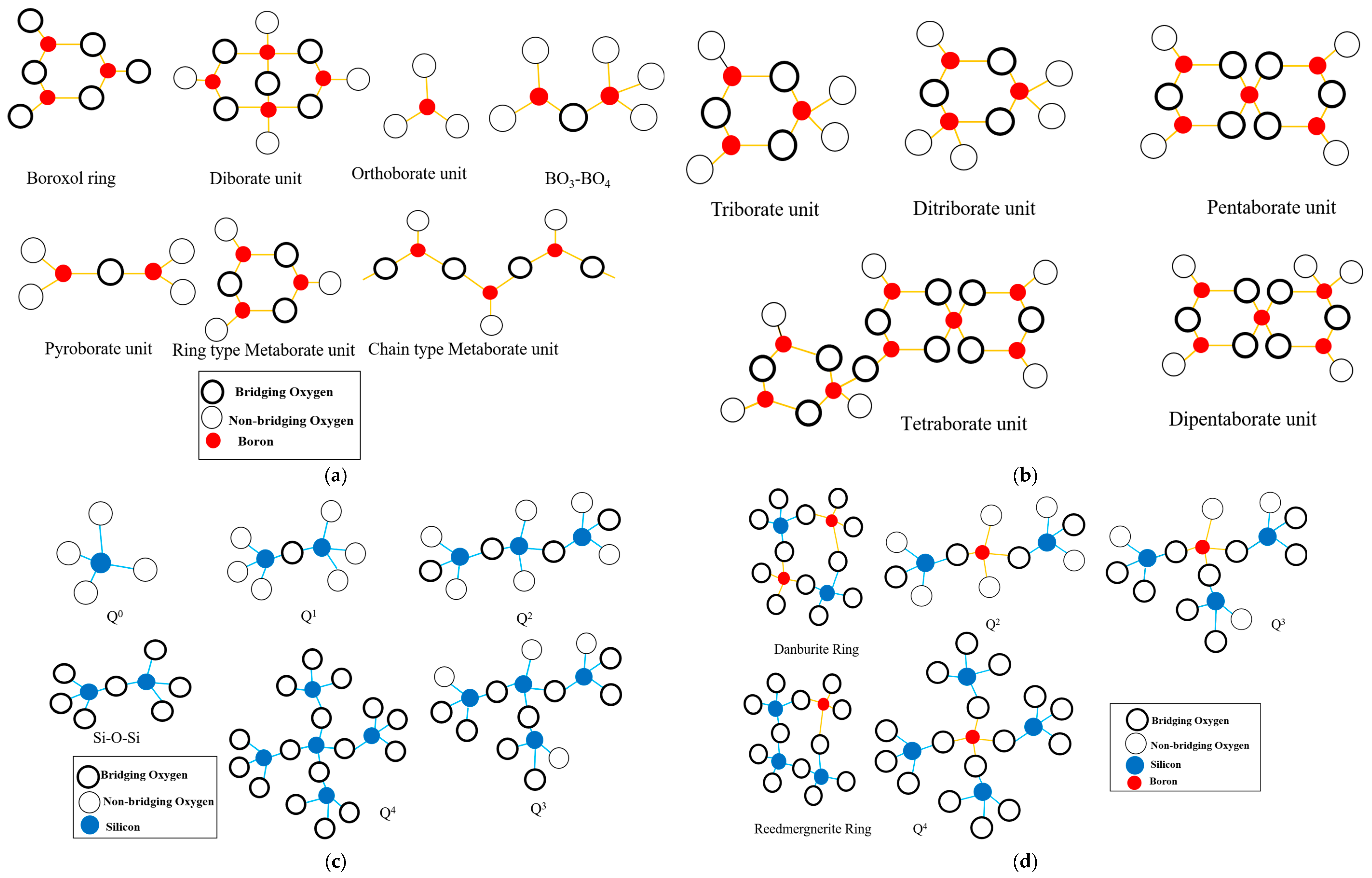
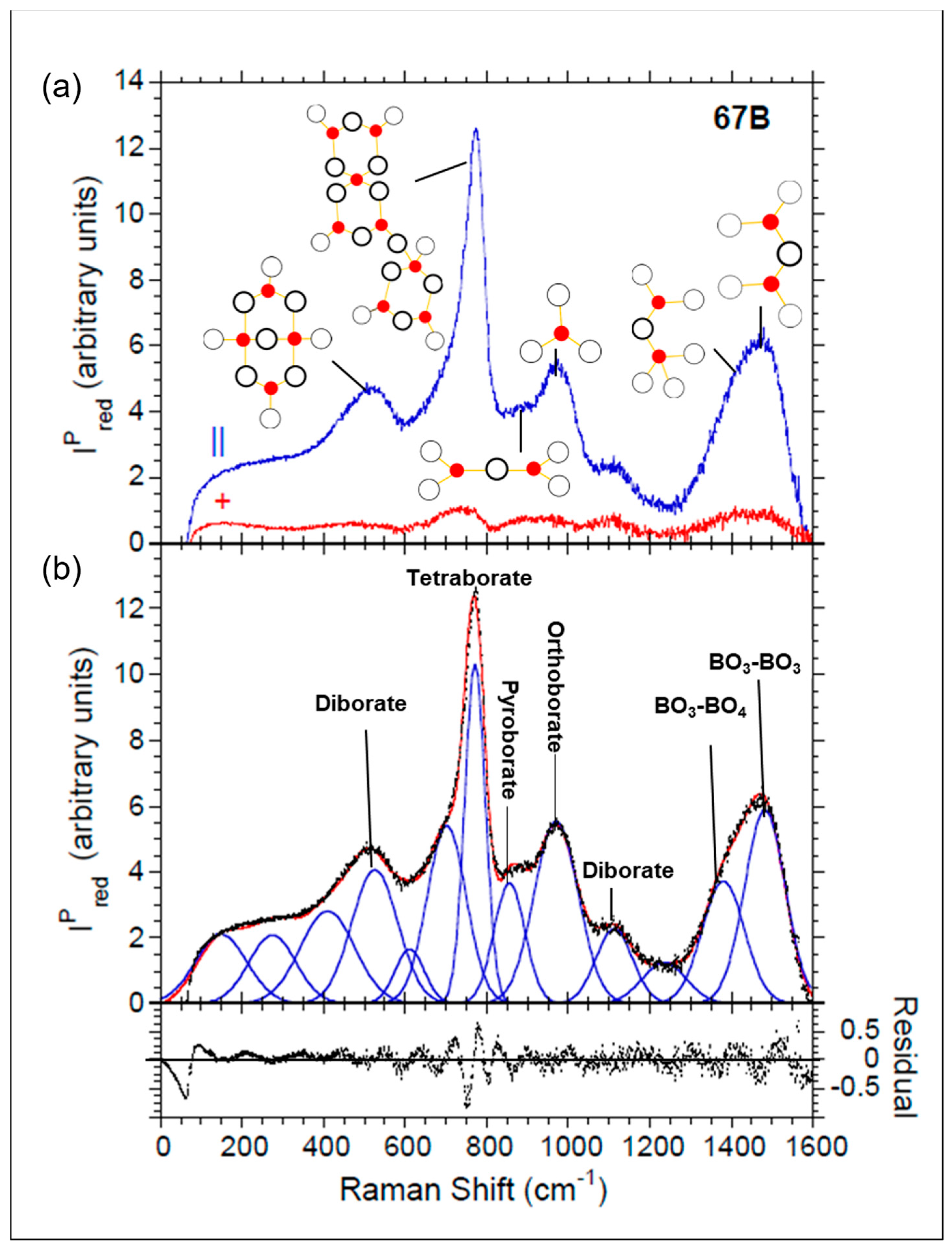
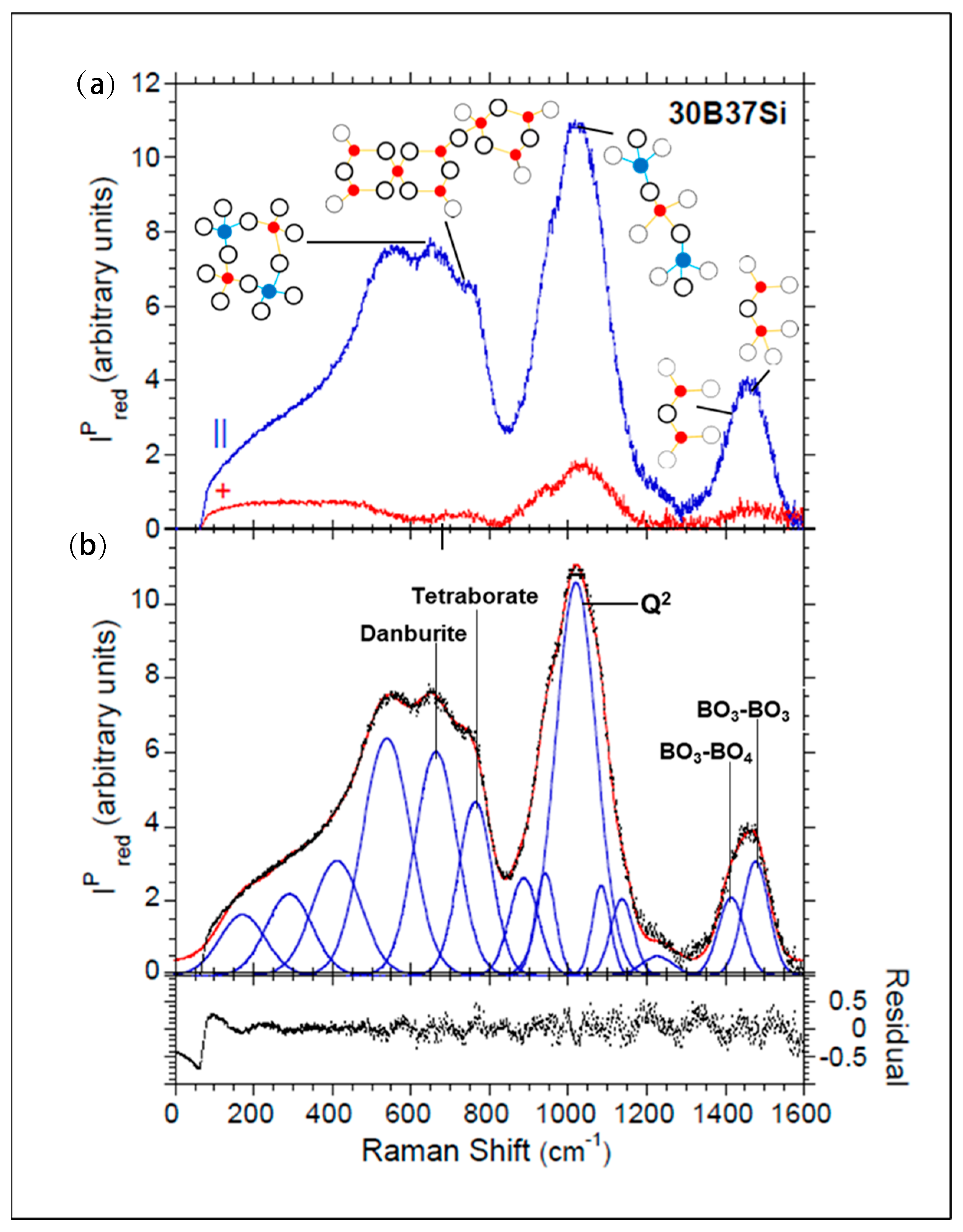



| Glass ID | Li2O (Mole %) (Nominal) | Al2O3(Mole %) | B2O3 (Mole %) (Nominal) | SiO2(Mole %) | B2O3 (%Mole) | SiO2 (%Mole) | R* = 0.5 + 0.0625 K | Tg (°C) | ||||
|---|---|---|---|---|---|---|---|---|---|---|---|---|
| (Nominal) | (XRF) | (Nominal) | (XRF) | |||||||||
| 67B | 30 | 3 | 2.60 | 67 | 0 | 0.00 | 100 | 0 | 0 | 0.40 | 0.5 | 442 |
| 60B7Si | 30 | 3 | 3.37 | 60 | 7 | 6.15 | 89.5 | 10.5 | 0.12 | 0.50 | 0.51 | 446 |
| 50B17Si | 30 | 3 | 3.60 | 50 | 17 | 15.79 | 74.6 | 25.4 | 0.34 | 0.60 | 0.52 | 450 |
| 40B27Si | 30 | 3 | 4.40 | 40 | 27 | 24.43 | 59.7 | 40.3 | 0.68 | 0.75 | 0.54 | 461 |
| 30B37Si | 30 | 3 | 3.52 | 30 | 37 | 36.00 | 44.8 | 55.2 | 1.23 | 1.00 | 0.58 | 458 |
| 20B47Si | 30 | 3 | 3.51 | 20 | 47 | 45.21 | 29.9 | 70.1 | 2.35 | 1.50 | 0.65 | 456 |
| 10B57Si | 30 | 3 | 3.60 | 10 | 57 | 58.04 | 14.9 | 85.1 | 5.70 | 3.00 | 0.86 | 463 |
| 67Si | 30 | 3 | 3.65 | 0 | 67 | 66.40 | 0 | 100 | --- | --- | --- | 475 |
| Vibrational Assignment | 67B | 60B7Si | 50B17Si | ||||||
|---|---|---|---|---|---|---|---|---|---|
| Position (cm−1) | Peak Width | Area | Position (cm−1) | Peak Width | Area | Position (cm−1) | Peak Width | Area | |
| Diborate (506 cm−1) [29,39] | 527 | 133 | 575 | 527 | 135 | 746 | 543 | 154 | 994 |
| Ring-type metaborate (600–650 cm−1) [29,30,31,32] | 612 | 84 | 148 | 607 | 83 | 142 | 599 | 90 | 0 |
| Chain-type metaborate (700–735 cm−1) [29,30,31,32] | 703 | 113 | 646 | 701 | 126 | 890 | 690 | 123 | 790 |
| Tetraborate (740–775 cm−1) [29,38] | 772 | 59 | 649 | 772 | 63 | 612 | 769 | 72 | 561 |
| Pyroborate (820 cm−1) [29,30,31,32,40] | 857 | 89 | 347 | 854 | 91 | 364 | 861 | 105 | 373 |
| Orthoborate (875–1000 cm−1) [29,39,62] | 971 | 127 | 745 | 973 | 133 | 1009 | 981 | 134 | 1127 |
| Diborate (1000–1110 cm−1) [34,52,57] | 1114 | 106 | 254 | 1109 | 110 | 326 | 1098 | 104 | 357 |
| BO3 symmetric stretch (1200 cm−1) [31,35,43] | 1236 | 127 | 168 | 1233 | 125 | 195 | 1233 | 125 | 179 |
| BO3-BO4 (1300–1450 cm−1) [28,29,30,31] | 1381 | 122 | 479 | 1384 | 125 | 517 | 1393 | 125 | 358 |
| BO3-BO3 (1450–1600 cm−1) [28,29,30,31] | 1483 | 117 | 733 | 1480 | 112 | 783 | 1475 | 109 | 597 |
| Vibrational Assignment | 40B27Si | 30B37Si | ||||
|---|---|---|---|---|---|---|
| Position (cm−1) | Peak Width | Area | Position (cm−1) | Peak Width | Area | |
| Vibration of bridge bonds B-O-B, B-O-Si, Si-O-Si (500–600 cm−1) [44,45,52] | 543 | 155 | 1072 | 539 | 144 | 980 |
| Danburite and reedmergnerite rings [42,52,53] | 681 * | 118 * | 742 * | 664 | 121 | 809 |
| Tetraborate (740–775 cm−1) [29,38] | 765 | 79 | 505 | 764 | 102 | 505 |
| Orthosilicate–pyroborate (850 cm−1) [40,67] | 858 | 120 | 380 | 888 | 87 | 241 |
| Q2 (950 cm−1) [46,47,48] | 952 | 93 | 548 | 942 | 59 | 174 |
| Q3′ (1020 cm−1) [46,47,48] | 1014 | 80 | 546 | 1020 | 121 | 1369 |
| Q3′‘ (1080 cm−1) [46,47,48,51] | 1079 | 90 | 448 | 1085 | 54 | 138 |
| Q4 (1140 cm−1) [46,47,48] | 1148 | 88 | 117 | 1138 | 68 | 148 |
| Symmetric stretching of BO3 units (1200 cm−1) [31,35,43] | 1234 | 121 | 143 | 1227 | 92 | 50 |
| BO3-BO4 (1300–1450 cm−1) [28,29,30,31] | 1391 | 117 | 273 | 1415 | 77 | 172 |
| BO3-BO3 (1450–1600 cm−1) [28,29,30,31] | 1473 | 107 | 529 | 1478 | 78 | 255 |
| Vibrational Assignment | 20B47Si | 10B57Si | 67Si | ||||||
|---|---|---|---|---|---|---|---|---|---|
| Position (cm−1) | Peak Width | Area | Position (cm−1) | Peak Width | Area | Position (cm−1) | Peak Width | Area | |
| Breathing vibration in four-membered rings (485 cm−1) [45,50] | 531 | 138 | 1119 | 509 | 127 | 855 | 490 | 98 | 781 |
| Breathing vibration in three-membered rings (600 cm−1) [52,63,65] | 641 ** | 138 ** | 772 ** | 601 | 131 | 1279 | 585 | 131 | 1790 |
| Stretching plus bending of Si-O-Si bond (654 cm−1) [44,45] | 690 | 121 | 436 | 673 | 117 | 735 | 685 | 130 | 635 |
| Si-O-Si bending modes (800 cm−1) [47,66] | 777 | 89 | 314 | 774 | 89 | 333 | 790 | 83 | 280 |
| Orthosilicate (850 cm−1) [67] | 891 | 87 | 239 | 881 | 87 | 156 | 873 | 41 | 47 |
| Q2(950 cm−1) [46,47,48,55] | 941 | 59 | 253 | 950 | 76 | 774 | 952 | 79 | 811 |
| Q3′(1020 cm−1) [46,47,48,68] | 1018 | 105 | 1442 | 1016 | 72 | 841 | 1014 | 56 | 513 |
| Q3′‘(1080 cm−1) [46,47,48] | 1084 | 70 | 484 | 1076 | 87 | 1715 | 1077 | 83 | 2234 |
| Q4(1140 cm−1) [46,47,48,55] | 1145 | 68 | 176 | 1159 | 68 | 150 | 1156 | 88 | 407 |
| Symmetric stretching of BO3 units (1200 cm−1) [31,35,43] | 1227 | 92 | 68 | 1229 | 92 | 64 | --- | --- | --- |
| BO3-BO4(1300–1450 cm−1) [28,29,30,31] | 1416 | 62 | 121 | 1449 | 87 | 201 | --- | --- | --- |
| BO3-BO3(1450–1600 cm−1) [28,29,30,31] | 1476 | 74 | 202 | 1512 | 45 | 30 | --- | --- | --- |
Disclaimer/Publisher’s Note: The statements, opinions and data contained in all publications are solely those of the individual author(s) and contributor(s) and not of MDPI and/or the editor(s). MDPI and/or the editor(s) disclaim responsibility for any injury to people or property resulting from any ideas, methods, instructions or products referred to in the content. |
© 2024 by the authors. Licensee MDPI, Basel, Switzerland. This article is an open access article distributed under the terms and conditions of the Creative Commons Attribution (CC BY) license (https://creativecommons.org/licenses/by/4.0/).
Share and Cite
Kafle, A.P.; McKeown, D.; Wong-Ng, W.; Alsubaie, M.; Alenezi, M.; Pegg, I.L.; Dutta, B. Raman Spectroscopy and Electrical Transport in 30Li2O• (67−x) B2O3•(x) SiO2•3Al2O3 Glasses. Electron. Mater. 2024, 5, 166-188. https://doi.org/10.3390/electronicmat5030012
Kafle AP, McKeown D, Wong-Ng W, Alsubaie M, Alenezi M, Pegg IL, Dutta B. Raman Spectroscopy and Electrical Transport in 30Li2O• (67−x) B2O3•(x) SiO2•3Al2O3 Glasses. Electronic Materials. 2024; 5(3):166-188. https://doi.org/10.3390/electronicmat5030012
Chicago/Turabian StyleKafle, Amrit P., David McKeown, Winnie Wong-Ng, Meznh Alsubaie, Manar Alenezi, Ian L. Pegg, and Biprodas Dutta. 2024. "Raman Spectroscopy and Electrical Transport in 30Li2O• (67−x) B2O3•(x) SiO2•3Al2O3 Glasses" Electronic Materials 5, no. 3: 166-188. https://doi.org/10.3390/electronicmat5030012
APA StyleKafle, A. P., McKeown, D., Wong-Ng, W., Alsubaie, M., Alenezi, M., Pegg, I. L., & Dutta, B. (2024). Raman Spectroscopy and Electrical Transport in 30Li2O• (67−x) B2O3•(x) SiO2•3Al2O3 Glasses. Electronic Materials, 5(3), 166-188. https://doi.org/10.3390/electronicmat5030012






